
- posted: Nov. 04, 2019
November is National Diabetes Awareness Month and an estimated 30.3 million people have diabetes in the United States. That’s 9.4% of our population, and this number has been steadily on the rise. In addition, 84.1 million Americans age 18 and older are considered prediabetic. The total cost of diagnosed diabetes in the United States is $327 billion. Diabetes Awareness Month not only helps bring awareness to disease but also helps educate the public about the risk factors, complications and management of diabetes mellitus. Some healthcare clinics will offer free diabetic checks, including blood glucose tests, foot screenings and eye exams.
Diabetes can be accompanied by a handful of secondary complications that can range from mild to severe. The most common areas of the body to be secondarily affected by diabetes are the eyes, feet and skin. About 60% of people with diabetes develop peripheral neuropathy – a decrease in sensation to the feet - but do not realize it. This can lead to a decrease in the ability to recognize injury and can ultimately lead to infections, ulcers, and possibly amputation. Over the years, there has been a decrease of lower limb amputations in the United States. This is believed to be linked to improved diabetes management and patient education.
Risk factors for diabetes include: family history of diabetes, obesity, inactivity, increased age, history of gestational diabetes, polycystic ovarian syndrome, high blood pressure, and abnormal cholesterol and triglyceride levels. If you have any of these factors, now would be the best time to get tested. Diabetes is diagnosed through a fasting blood glucose level and it is a simple and fast test. Getting tested now as a precaution may save you a lifetime of devastating consequences.
Once diagnosed with this disease, it is manageable and requires a lifestyle adjustment. The most important thing a diabetic should do is stay on top of their blood sugar levels. If you have been diagnosed with diabetes, self-monitor your glucose levels frequently. If your glucose is in control and managed well this will decrease your risk for serious, long-term consequences including amputation, blindness and heart attack.
For managing this disease, the best outcome is for the patient and their providers to work as a team. Seeing a podiatrist at least once a year for an annual foot examination is ideal. If there are secondary complications that are discovered at the visit, such as peripheral neuropathy or peripheral vascular disease, visits to the podiatrist might be more frequent.
For more information visit the American Diabetes Association website at www.diabetes.org.
If you have been diagnosed with diabetes mellitus or experience any changes in your foot health, please consider making an appointment with Dr. Margaret Withrow or Dr. Dylan Kaumaya at Roadrunner Foot and Ankle.
